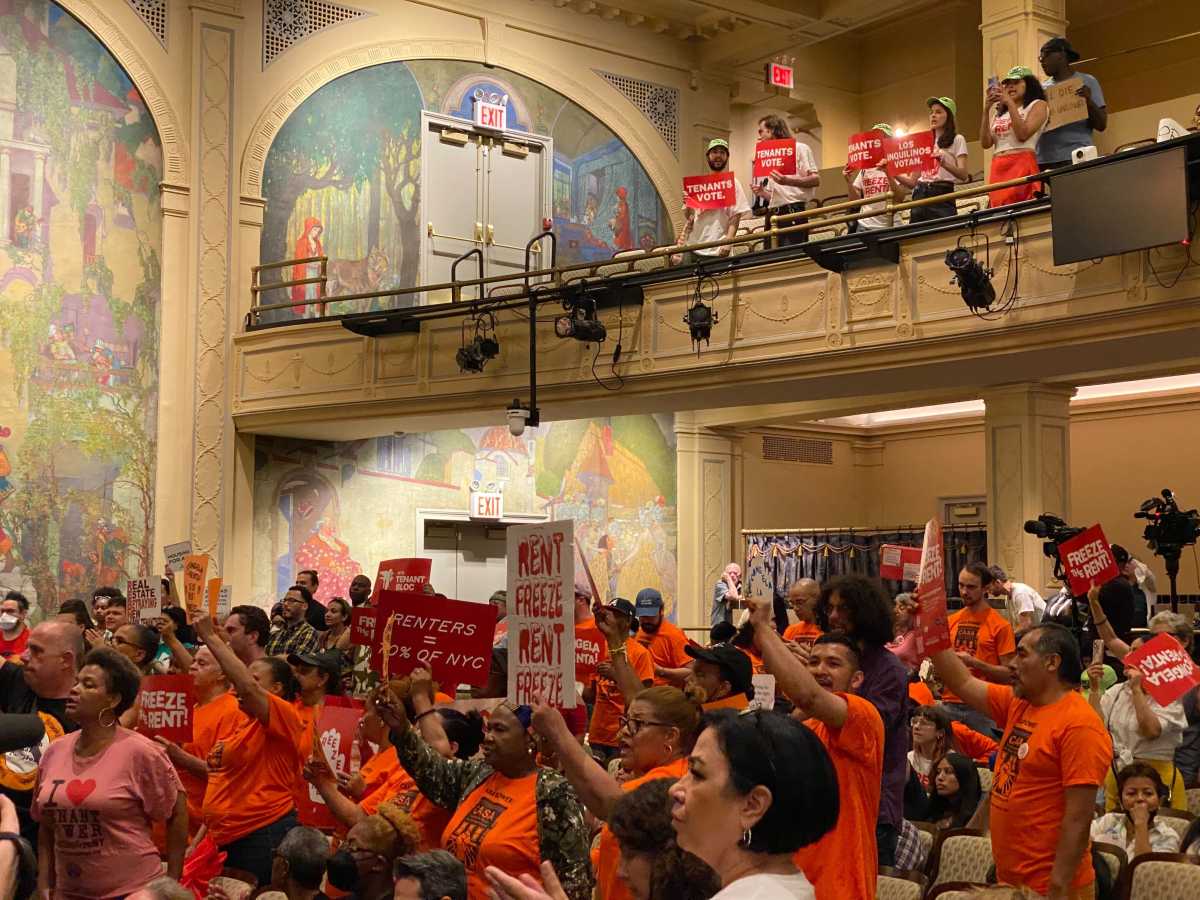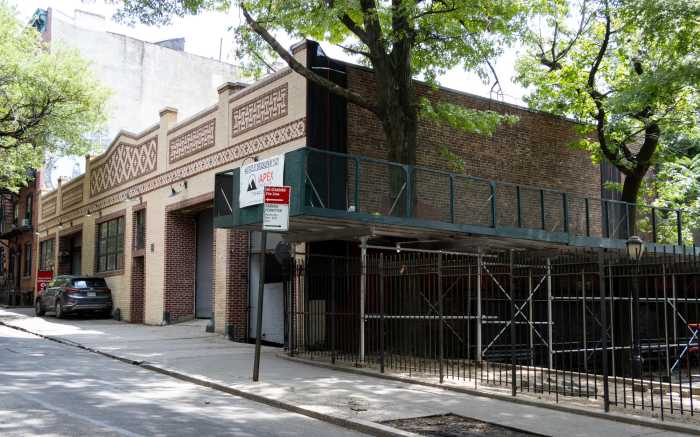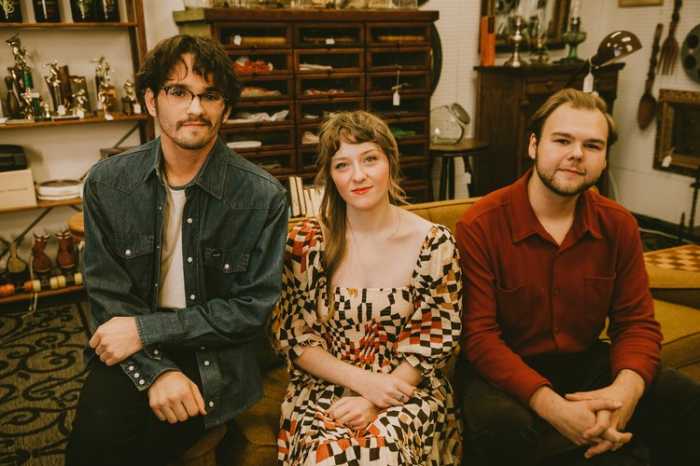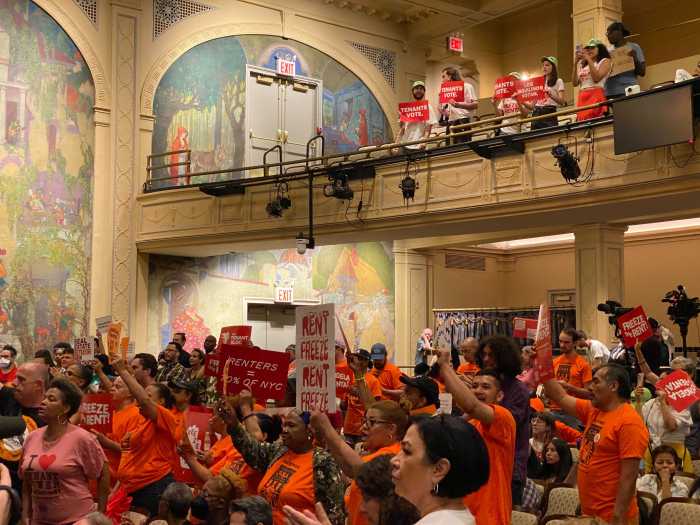Community Board 2 committee members revolted against the board’s
chairwoman in two votes this week that called for the board to remove
itself from negotiations with Forest City Ratner on a local benefits agreement
for the planned Atlantic Yards project.
The board members found out in the past two weeks — first from a
report published in The Brooklyn Papers and then in an announcement by
CB2 Chairwoman Shirley McRae at the full board meeting last Wednesday
— that for the past 10 weeks McRae and District Manager Robert Perris
have been involved in closed-door negotiations with Forest City Ratner
officials and members of several community groups that are in favor of
the plan to build a basketball arena, three office skyscrapers and 4,500
apartments in Prospect Heights east of the intersection of Flatbush and
Atlantic avenues.
Chairpersons and district managers from CB6 and CB8 have also been involved
in the negotiations for a so-called community benefits agreement intended
to provide for local and minority and women hiring.
Saying she sought suggestions and input from the full board after word
of the dealings broke, McRae handed out to committee chairs at last week’s
meeting a sparse, draft outline of topics being discussed for inclusion
in such a community agreement. But committee members, faced with the non-specific
outline and an upcoming deadline for the panels to render a recommendation,
were confused.
Although District Manager Robert Perris advised them not to worry about,
as he put it, “Ratner’s schedule,” which aims to have a
completed CBA by Nov. 1, Perris said comments nevertheless had to be filed
at the CB2 offices by Oct. 25, and would be presented at the Nov. 10 monthly
board meeting.
Confused, two of the three committees decided that the draft was too fuzzy
to warrant any comment.
And despite clarifying statements issued by McRae and Perris, committee
members were concerned, in meetings Tuesday and Wednesday, that participation
might connote full involvement.
“The discussion is not a referendum on the proposed project itself,”
Perris told members of the Traffic-Transportation committee Tuesday. “Work
on a CBA is not an endorsement of the project,” he said, and encouraged
members to focus on ideas and suggestions based on the outlines.
“Any suggestion can be sent to the community board until Monday,
Oct 25,” said Perris, and he provided the address and e-mail for
information purposes: 350 Jay St., 8th Floor, Brooklyn, NY 11201 or cb2k@nyc.rr.com.
But his statement did little to assuage fears by committee members, as
well as community members in attendance, that they were being manipulated
by a developer — Forest City Ratner principal owner Bruce Ratner
— who still had not provided thorough financing
information or detailed plans for the project.
Although the committees came to conclusions in individual sessions, during
which both board members and guests aired discontent, the suggestion to
make a motion for withdrawal from the CBA negotiations was agreed upon
by both the Land Use and Traffic-Transportation committees.
McRae could not be reached for comment on the committee decisions by press
time.
At the Land Use Committee meeting on Oct. 20, Forest City Ratner Executive
Vice President Jim Stuckey presented hopeful answers to committee and
community members, who grew increasingly unsatisfied with his responses.
“I’ve looked at this, Mr. Stuckey,” said committee member
Ken Diamondstone, a longstanding board member, waving the one double-sided
page that comprises the draft of the CBA. “It looks to me like a
laundry list. This is not a community agreement, or even the beginning
of a community agreement.”
Diamondstone said he had never seen something distributed to all the committees
for consideration simultaneously, but thought he knew why this was an
exception.
“The reason you distributed this is not because you really want our
input. The reason is you want us to tacitly engage so that you can go
to the press and co-opt us and say, ‘We’ve gone to the community
boards and they’ve participated with us,’” Diamondstone
charged.
The Land Use committee chairman, Ernie Augustus, cut him off. “This
is a big community board,” Augustus said. “There are people
who oppose this project, and there are people who support it. This community
board has to articulate the broad spectrum. No, we’re not going to
disengage. You can be in negotiation. You don’t have to be in conflict
or an accomplice to negotiate. But you have to be engaged.”
But Ursula Hahn, who sits on the Traffic-Transportation committee and
attended the Land Use meeting, asked how the board could be expected to
offer anything when they had no idea what to expect from the massive development
proposal.
“We don’t have any details yet to work with,” said Hahn.
Stuckey responded using some favorite catchphrases.
“You have to do things in a context,” he said, “where you
can’t ignore issues like secondary displacement. And you can’t
ignore issues like affordable housing for people when you just drop a
development into an area.”
The Atlantic Yards plan depends on the taking of private property under
the state’s authority of eminent domain. The rest would be built
over Metropolitan Transportation Authority rail yards pending the sale
of those air rights to Forest City Ratner.
Following Stuckey’s comments, board members asked why the project
was skirting the city’s rigorous Uniform Land Use Review Procedure
(ULURP) in favor of the far less stringent state review process. Doris
Golub, a member of both CB2 and the Fort Greene Association, said Forest
City Ratner should be happy to undertake the seven-month review —
which calls for public hearings before the community board, borough president,
City Planning Commission and City Council — as it could only benefit
the support of their design.
“When the project comes out at the other end you have people in favor
of the project,” she said.
Despite the high-level Forest City Ratner official fielding questions
at the Land Use committee hearing, several board members were only more
incited after he left.
When discussion turned to the possibility of voting on a motion to hold
off on any CBA negotiations until the board was supplied with further
information, chairman Augustus grew livid.
“If Jim Stuckey says it is a state process, it is a state process,”
Augustus affirmed.
But Kenn Lowy, who had drafted wording of a motion for the traffic committee
the night before, asked to make a motion at the Land Use meeting.
“Until this board and the community are given all the information
on this proposed project, including public hearings and information on
public money being spent on the project, we should not endorse, comment
or participate in the proposed CBA,” he read from his motion.
Members of the Traffic-Transportation committee, which was the first group
to take a vote after the CBA draft was released on Oct. 13, voted in favor
of the “no-comment” motion 10-1 with two abstentions. The no
vote was cast by Jon Quint, an attorney, who argued that legal ground
would be lost if the board didn’t participate now.
But the Land Use committee had a longer, more contentious battle, as Augustus
grew convinced the motion was part of a conspiracy against the project
itself, even by longstanding board members.
“This thing was circulated before I even called this meeting to order,
at 6:15 pm,” the committee chair said. “They call it political
machinations, political games. I’m not used to short-circuiting this
process.”
And though he tried to prolong the vote on the motion, first by refusing
to act on the vote when it was first moved, immediately following Stuckey’s
departure, and then again following public discussion, the committee voted
7-4 in favor of the “no-comment” motion.
The only other CB2 committee that met within the timeframe before comments
were due was the parks committee, which neither came to a conclusion nor
offered any suggestions on the CBA draft. Sadie Nixon, a CB2 office staffer,
said no other committees would be meeting on the CBA before the deadline.
“They aren’t having any special meetings,” she said, but
suggested crossover members who were part of more than one committee would
have a chance to review it.
Though Forest City Ratner’s CBA is anticipated for completion in
just a week’s time, what role the boards will have in its development
remains unclear.
Stuckey ventured his doubt of the board’s legal authority to sign
a document. The chairs have sat in on agreements, hence “participated,”
he said, and may continue to do so until their monthly meeting, in which
case board members who fear having their power “co-opted” may
have already missed out.
Meanwhile, Ratner’s group continues to meet twice weekly to develop
the CBA.
“Nothing’s going to happen until the whole board votes on it,”
said Nixon, which would be after the Ratner deadline.























